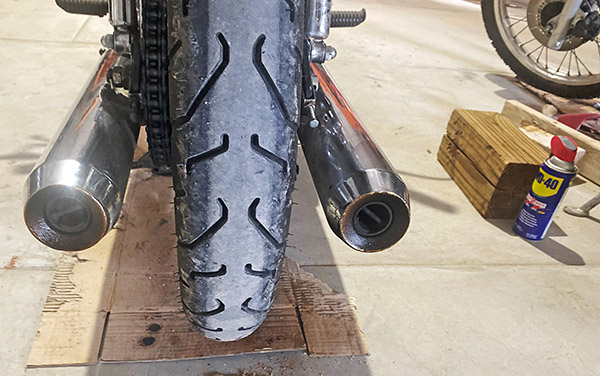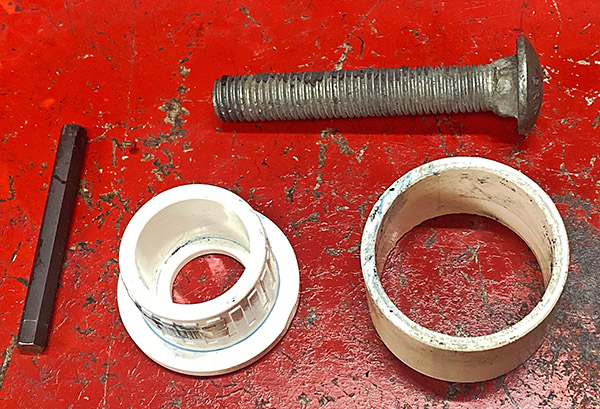The ExhaustNotes website consumes a lot of content. Berk writes most of it and he’s always up to something interesting. I feel bad that he has to carry the load, but I just don’t have that much to write about. Here in the wilds of New Mexico we spend a lot of time and energy just surviving. Take water, for instance.
Our place has a combination of well water and rainwater. The well supplies the tiny shack we live in and the cistern for rainwater catches ½ of the shed roof runoff. It all worked ok until the well ran dry. Our well is only 85 feet deep and since our land sits at 6000 feet elevation you’ve got to figure the water in the well comes from a trapped source. Maybe there’s a layer of impervious stone or clay at 90 feet. The well was already dug when we bought the place, but the pump was dead.
Colleen and I installed a new pump using the existing piping and we had a reliable supply of water. The well inspector said it was good for 1.5 gallons a minute, which isn’t a lot unless you count the minutes in a day. We have a 40-gallon pressure tank with a pressure switch to turn the pump on and off.
The system worked fine until a month ago when the water stopped flowing. The well was flat out of water. The well guy told me this happens all the time. Maybe someone below me used a lot of water, maybe the well is silted up or maybe wells just go dry after 27 years. To get back in the swim I ran two, 150-foot-long garden hoses to a bib outside of the shack and fed the house from the shed water supply.
We let the well rest for about a week and then tried it. We had water again. Everything was fine until a few days ago when the water ran out again. Obviously, we are going to need a better water supply.

We decided to go with a hybrid, part well water, part rainwater, part purchased water set up. We’re getting a 3000-gallon storage tank that will sit next to the well house. Of course, the new tank will require a concrete slab. During monsoon season I can dump excess water from the shed tank into the lower, 3000-gallon tank. Probably 4 or 5 months of the year we can get by on rain water unless there is a drought.
We’re hoping this will take much of the load off the well and give it a chance to recharge from wherever its water comes from. If we need to we can purchase water. Many homes around here buy water and store it in tanks; they have no well because well drilling is expensive and you pay for the work whether the driller hits water or not. A typical well a few hundred feet deep will run around $30,000. If they hit water the first time.

The new system will require a bit of re-plumbing. Instead of directly feeding the shack the well output will dump into the 3000-gallon storage tank and from there the water will go to a jet type pump to provide pressure to the house. I’m hoping the tank will be a sort of battery to store the well water as I can adjust the well output to a trickle to not outrun the well’s capacity per minute. If we are lucky the slower draw will buy a few more years from our well, if not we may drill another, deeper well.
Using rainwater is way nicer than the mineral-rich stuff we get from the well. Soap makes better suds, sinks and faucets stay cleaner and you don’t get those stalactites of gypsum hanging off the aerators. Bought water comes from a city supply and so has all manner of junk floating around.
Future water infrastructure plans include a second, 2500-gallon tank up at the shed. I lost thousands of gallons this monsoon season due to the single tank being full. It drives me crazy seeing that water spilling onto the ground. Installing another rainwater tank to handle runoff from the Carriage House roof should be good for 3 or 4 thousand gallons during monsoon. One day I will get around to guttering the other half of the shed roof and that should double production from the upper level. If we get enough storage I think we can operate the ranch using just rainwater, giving the old well a much-deserved rest. My job will be to move water from all the different tanks to the main 3000-gallon unit.
And this is why I don’t have much fun stuff to write about lately. Things are falling apart faster than I can fix them. Men were given dominion over the Earth but it’s not an easy task to rule nature. I’m starting to think this ranch living is no country for old men. Maybe one day when we get really old we’ll get a suburban house. I’ll have my own garage door opener or a breakfast nook.
Help us pay for all these tanks, pumps, gutters, and more: Please click on those popup ads!
Never miss an ExNotes blog:





















































